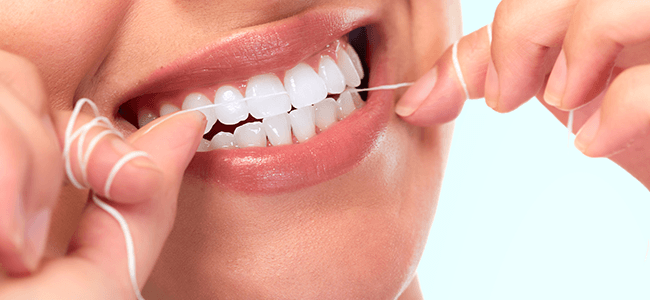
Prevention
We are caring for your teeth to keep them healthy with various forms of treatment.
Dental Cleaning
Dental cleaning should be performed by professional dentists or dental hygienists exclusively. A routine dental cleaning should include scaling root planning and polishing. These three important steps are outlined in detail below.
Scaling
This is the removal of plaque and tartar from all tooth surfaces with different types of scaling being used in relation to the amount of plaque and tartar.
Dental hygienists perform traditional scaling by hand. Advances in technology have led to more modern methods such as electric scalers which allow dental cleaning to be done in much shorter period of time. However to achieve best results electric and manual scaling should be combined in dental cleaning.
Ultrasonic scaling uses a machine called a cavitron which uses sound waves to remove tartar. Ultrasonic scalers can only remove 50% of total tartar buildup so hand scaling must follow cavitron scaling.
Root planning
This is the cleaning of pockets to stop further gum problems. Root planning is used to treat perio conditions which are moderate to advanced gum diseases. When the gum is inflamed gum pockets become deeper and they lose bone connections inside. The deeper these pockets are the easier it is for them to trap plaque deposits and make the gum worse.
Root planning is essentially inserting the pointy front of handle scalers into below the gum pockets to clean plaque buildup. Sometimes local anesthesia is needed to prevent any feeling of pain and depending on the degree of difficulties root planning can take several dental visits.
Polishing
Polishing is the finishing touch of rubbing on the surface of the teeth. There are two kinds of polishers; the prophy jet polisher and the rubber tip polisher with prophy paste. Prophy jet polishing works by spraying high pressured water mixed with baking soda paste onto the surface of your teeth. This powered water can wash away the residue and plaque while the baking soda removes the brown and yellow stains and neutralizes the acidic conditions in your mouth. Rubber cup polishing employs a low-speed hand piece with a rubber cup tip mounted on the top that contains a polishing paste that is made of abrasive ingredients ideal for removing stains.
The amount of time needed for dental cleanings depend on factors ranging from plaque deposits complication of dental restorations and your gingival health. People with more tartar and plaque buildup need longer dental appointments than those who have relatively cleaner teeth.
Cleaning should be performed every six months to prevent excessive plaque build up. As mentioned, people with deep gum pockets should have a dental cleaning every 3 months. Lack of cleaning allows the growth of plaque which if left unchecked, can lead to the various types of conditions involved in tooth decay.
It’s good to Know
If you are an adult this part is late for you, but this section is just in time for your children nieces, nephews, grandchildren, or the other young ones in your life. The time to begin caring for your teeth is before you have them. And the stuff to begin with is water. As your body is making your teeth, a healthy diet, good health care and fluoride in your food and water do the most for making teeth strong, cavity resistant and attractive. You can not change your childhood, but you can give your child a healthy start.
Contact your B.C. municipal water provider and ask if the fluoride content is 1 ppm (part per million). This level is safe, and when children get fluoride in their food and water before their teeth erupt, those teeth are strengthened from the inside and for the life of the tooth – as soon as teeth come in. That is when you begin brushing your child’s teeth. When you cannot reach all surfaces of all teeth with the brush – that is the time to start flossing.
Loss of teeth with age is not inevitable. With a little time and effort you can prevent most cavities or gingivitis. Though starting proper care of your smile early is better than starting later, taking care of yourself always has benefits.
Brushing
To brush properly use a brush with soft bristles and do not press the brush hard against the teeth. Hard bristles or too much pressure can wear the teeth down. Light pressure is more comfortable, cleans well and helps your teeth last longer. When you brush do not imitate what you see in toothpaste and toothbrush commercials. They usually show bad technique! Do not move the brush side to side, but up and down. Use a tooth paste with fluoride to strengthen the enamel. Better still; use a fluoride toothpaste labeled “tarter control”. A tarter control toothpaste slows the change of plaque into tarter, so your teeth will stay cleaner longer. Only use a dab of paste on the brush about the size of a pea. More is actually less effective.
Flossing
The idea with flossing is to remove the plaque which forms between your teeth and which is not reached by your toothbrush. Use a floss which is comfortable for you (waxed, unwaxed, string or ribbon); it is the daily use, not the type which matters. The best approach is to floss before each brushing. It is extremely important to use the right technique. Technique is more important than floss type, and actual knowledge of what is happening during the cleaning/flossing procedure is even more important. See our demonstration during your checkup in our Carleton Square Dental Centre.
Bad Breath (Halitosis) – Causes
The majority of bad breath problems begin in the mouth.
- Bad breath that is of oral cavity origin can be traced to a sulfur compound produced by bacteria. Dead and dying bacterial cells release this sulfur compound which gives the breath an unpleasant odor.
- Bacterial plaque and food debris accumulate on the back of the tongue. The tongue’s surface is extremely rough and bacteria can accumulate easily in the cracks and crevices.
- Large amounts of sulfur compounds can be produced in this area, making it a frequent site of origin for bad breath.
- The tooth attracts bacteria containing plaque and if not cleaned regularly and thoroughly, this can result in large accumulations of bacteria which result in bad breath.
- People who have periodontitis often experience bad breath because of bacteria accumulating in areas that are not cleaned easily, such as deep pockets around teeth.
- Fortunately, treatment is very effective for people who have bad breath of mouth origin.
Halitosis – Oral Health Treatment
- Treatment begins with a complete oral examination and health history; you may have an “odor-meter” test done. This test can accurately measure the volatile sulfur gases and the extent of a halitosis problem.
- Periodontal disease and /or cavities should be treated and repaired.
- Oral infections must be eliminated or impacted teeth may need to be removed.
- Good oral hygiene must be stressed, including cleaning the teeth and tongue. Once the oral infection is treated and cured, mouth wash and toothpastes may have some effectiveness in managing oral odor. Ask general or cosmetic dentist for a product that may be helpful to you.
Bad breath sufferers should feel encouraged to seek treatment because of the high success rate in managing the problem.
CONTACT US
CONTACT
Phone: 604-294-0294
Fax: 604-299-4151
carletonsquare@shaw.ca




